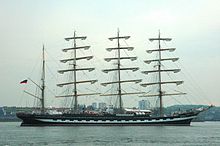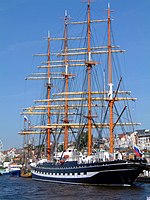Kruzenshtern (ship)
|
The Kruzenshtern in Hamburg
|
||||||||||||||||||||
|
||||||||||||||||||||
|
||||||||||||||||||||
|
||||||||||||||||||||
|
||||||||||||||||||||
|
||||||||||||||||||||
|
||||||||||||||||||||
The Russian sailing training ship Kruzenshtern ( Russian Крузенште́рн , originally Padua ) is a four-masted steel barque , which is named after the German-Baltic captain and Russian admiral Adam Johann von Krusenstern . The home port of the windjammer is Kaliningrad .
The Kruzenshtern is the only one of the Flying P-Liner built for the F. Laeisz fleet that is still in service today.
history
The ship was launched as Padua in 1926 at the Joh. C. Tecklenborg shipyard on the Geeste in Wesermünde (today Bremerhaven ) . With ships like the Pamir and the Passat, it was one of the famous Flying P liners operated by the Hamburg shipping company F. Laeisz, whose names traditionally began with a “P”. On the maiden voyage from Hamburg to Talcahuano ( Chile ) it took 87 days.
The Padua was then used as a cargo sailor and sailing training ship. Among other things, she brought building materials to South America , returned from there with saltpeter (see saltpeter trips ) and later also transported wheat from Australia . In 1933/1934 she covered the route from Hamburg to Port Lincoln in South Australia in the record time of 67 days.
In the 1930s and 1940s, Padua was temporarily used as a film set several times, for example for Die Meuterei auf der Elsinore (published in 1935 or, according to other information, in 1936), for A Heart Goes Anchor (published in 1940) and in Große Freiheit No. 7 ( published 1944) with Hans Albers .
The Padua had after the Second World War in 1946 as reparations to the Soviet Union be given. The black hull was given a white pattern and the ship was renamed Kruzenshtern . After 1955 it was used several times as a film set for Soviet films.
Today the Russian Ministry of Fisheries uses the Kruzenshtern to train the offspring of the fishing fleet; Since 1974 she has taken part in many international regattas , including the Sail in Bremerhaven , which takes place every five years . Paying passengers (trainees) are also increasingly being taken along, who thus contribute to the maintenance of the ship.
Travel and captains
Well-known passages of the Padua were the journey from "Elbe 1" to Talcahuano, Chile, in 54 days (1927), from Mejillones , Chile, to the beacon " The Lizard " (England) in 72 days (1928) and from Hamburg to Wallaroo , Australia in 67 days (1933-1934). 1938-1939 she sailed on the route Bremen – Chile – Australia – Hamburg.

In 1926 Carl Schuberg became captain. The fastest journey, which is also a world record for square sailers, was made in 1938/39, from Hamburg to Chile and Australia back to Hamburg, in 8 months and 23 days under captain Richard Wendt. With the captains Robert Clauss and Jürgen Jürs she circled Cape Horn seven times (see Cape Hornier ). In 1941 Otto Schommartz - he had already circumnavigated Cape Horn 18 times with P-liners - became captain of the Padua. She sailed in the Baltic Sea during the war and was withdrawn to the Flensburg Fjord in 1944. In January 1946 it was handed over to the Soviet Union from Hamburg.
Renamed Kruzenshtern in the meantime , she often drove from the Baltic ports to the Black Sea under Pawel W. Vlasow and then under NT Schulga.
In 1974 she took part in " Operation Sail " (the Sail Training Association ). From 1976 to 1984 she drove under Iwan G. Schneider; then under the captains Gennady W. Kolomenski and Oleg K. Sedov. The current captain is Mikhail W. Novikov. In the transatlantic race from Canada to Liverpool, she achieved first place in a severe storm, which she was able to defend two years later.
In January 1981 the Kruzenshtern went to the Estonian Fisheries Industry . Instead of Riga , Tallinn became the home port. Ten years later it became part of the State Baltic Academy of the Fisheries Fleet with its home port in Kaliningrad.
Her greatest triumph was her victory in the race from Boston to Liverpool in "Operation Columbus '92" to celebrate 500 years of America . She reached the record speed of 17.4 knots (32.3 km / h).
In 2009, the Kruzenshtern took part in the Tallship Atlantic Challenge , but had to cancel it on the Hamilton (Bermuda) stage towards Boston (USA) due to a break in the foremast.
Others
The ship Kruzenshtern was a Russian coin devoted to gold with a nominal value of 1,000 rubles and a gold content of 155.5 grams.
literature
- Andreas Gondesen: The last Flying P-Liners. Pamir, Passat, their sisters and half-sisters, built between 1902 and 1926. published by the German Maritime Museum. Oceanum Verlag, Wiefelstede 2010, ISBN 978-3-86927-069-2 .
- Wolfgang Steusloff et al. (Ed.): The maiden voyage of the four-masted barque Padua. Supplement to the German Maritime Archive, published by the German Maritime Museum. Oceanum Verlag, Wiefelstede 2009, ISBN 978-3-86927-131-6 .
- Kurt Gerdau: Four-masted barque Padua ... a glorious ship. (= Men-Ships-Fates. Volume 1). Koehlers Verlagsgesellschaft, Herford 1978, ISBN 3-7822-0159-0 .
- Thomas Böttcher, Christine Hieber: Four-masted barque Kruzenshtern ex Padua . Oceanum Verlag, Wiefelstede 2016, ISBN 978-3-86927-077-7 .
Web links
- The Kruzenshtern website with current travel routes
- Information about the Kruzenshtern and photos on werften.fischtown.de ( Memento from October 20, 2006 in the Internet Archive )
- Diary of the cabin boy Herbert Schrödter about the voyage to Chile and back in 1927 (with pictures)
- Plan section and information on Ship-Modell-Today
Footnotes
- ↑ build no. 408 Shipyard board on board the Kruzenshtern. Retrieved on May 2, 2014.
- ↑ a b The history of the Kruzenshtern from being launched as "Padua" until today
- ^ German Maritime Museum - Photo: Padua ( Memento of November 10, 2013 in the Internet Archive ) Retrieved January 3, 2009.
- ↑ a b leaflet “Ships as places of knowledge. Meeting of the Flying P-Liner Kruzensthern (Padua) and Passat. Thursday, June 9th - Sunday, June 12th, 2016. (...) Concept and idea: Dr. Iris Klaßen and Susanne Kasimir "



